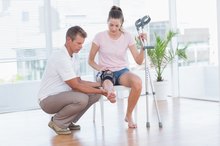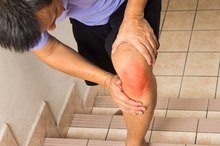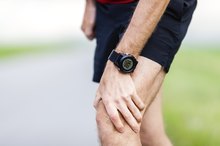How to Recover from a Knee Bone Bruise Caused by Running
The knee joint is not immune to sprains, strains and other running-induced injuries. If you have a knee bone bruise following a run, it could signify a problem. Training too hard, twisting motions -- like a sudden turn while running -- and improper stretching technique can all contribute to knee injuries in runners. You need to recover from that bruise before you can safely resume your run to protect your knee health.
Stop running if you notice a bruise. Cool down with a brisk walk home or a five-minute walk on the treadmill. Running when you are in pain is not recommended -- the bruise signifies an injury that can get worse with continued activity.
How to Treat a Deep Bone Bruise of the Knee
Learn More
Elevate the knee on a soft chair or ottoman, applying a soft pillow directly under the knee to prevent hyperextension and provide cushion. Try to keep the knee at or above the level of your heart to reduce any swelling.
Apply a lightweight towel or cloth over the knee. Get a bag of crushed ice, frozen peas or an ice pack and apply it to the bruised knee for 20 minutes. You can repeat using ice up to eight times a day as needed.
How to Care for a Bruised Knee
Learn More
Apply an elastic compression wrap if the knee is swelling along with the bruise. Start beneath the knee and wrap upwards in a diagonal motion. The wrap should feel supportive and snug, but not tight. Watch your toes and lower extremity for sensation, color or temperature changes that could mean the wrap is too tight.
Take two to three days off from your running regimen. A bruised kneecap can indicate a simple strain, excessive strike-force on hard pavement while running or a torn ligament -- all of which need rest to heal.
Resume your run, but pay attention to the bruised knee. Stretch your quadriceps and hamstrings thoroughly before and after each run, and make sure to land on the balls of your feet.
Start strengthening exercises for your quadriceps, which are the large thigh muscles that attach to your knee joint. Stand with your back against a flat wall and set your feet hip-width apart 6 to 8 inches in front of you. Pretend that you are going to sit down in a firm chair, and drop your buttocks towards the floor into a seated position. Hold the position for 10 seconds, and then return to a standing position. Repeat 10 times or as tolerated daily.
Tips
Running on hard surfaces can increase the incidence of knee injuries.
Warnings
Contact your doctor if the pain or swelling does not resolve within a week.
Related Articles
References
- National Institute of Arthritis and Musculoskeletal and Skin Diseases; Sports Injuries; April 2009
- FamilyDoctor.org; Running: Preventing Overuse Injuries; December 2010
- Lespasio MJ, Piuzzi NS, Husni ME, Muschler GF, Guarino A, Mont MA. Knee Osteoarthritis: A Primer. Perm J. 2017;21:16-183. doi:10.7812/TPP/16-183
- Kiapour AM, Murray MM. Basic science of anterior cruciate ligament injury and repair. Bone Joint Res. 2014;3(2):20-31. doi:10.1302/2046-3758.32.2000241
- Doral MN, Bilge O, Huri G, Turhan E, Verdonk R. Modern treatment of meniscal tears. EFORT Open Rev. 2018;3(5):260-268. doi:10.1302/2058-5241.3.170067
- Reinking MF. CURRENT CONCEPTS IN THE TREATMENT OF PATELLAR TENDINOPATHY. Int J Sports Phys Ther. 2016;11(6):854-866.
- Petersen W, Rembitzki I, Liebau C. Patellofemoral pain in athletes. Open Access J Sports Med. 2017;8:143-154. doi:10.2147/OAJSM.S133406
- Frush TJ, Noyes FR. Baker's Cyst: Diagnostic and Surgical Considerations. Sports Health. 2015;7(4):359-65. doi:10.1177/1941738113520130
- Huang YC, Yeh WL. Endoscopic treatment of prepatellar bursitis. Int Orthop. 2011;35(3):355-8. doi:10.1007/s00264-010-1033-5
- Beals C, Flanigan D. A Review of Treatments for Iliotibial Band Syndrome in the Athletic Population. J Sports Med (Hindawi Publ Corp). 2013;2013:367169. doi:10.1155/2013/367169
- Tsai CH, Hsu CJ, Hung CH, Hsu HC. Primary traumatic patellar dislocation. J Orthop Surg Res. 2012;7:21. doi:10.1186/1749-799X-7-21
- Ragab G, Elshahaly M, Bardin T. Gout: An old disease in new perspective - A review. J Adv Res. 2017;8(5):495-511. doi:10.1016/j.jare.2017.04.008
- Lee PYF, Nixion A, Chandratreya A, Murray JM. Synovial Plica Syndrome of the Knee: A Commonly Overlooked Cause of Anterior Knee Pain. Surg J (N Y). 2017;3(1):e9-e16. doi:10.1055/s-0037-1598047
- Vaishya R, Azizi AT, Agarwal AK, Vijay V. Apophysitis of the Tibial Tuberosity (Osgood-Schlatter Disease): A Review. Cureus. 2016;8(9):e780. doi:10.7759/cureus.780
- Zanon G, Di vico G, Marullo M. Osteochondritis dissecans of the knee. Joints. 2014;2(1):29-36.
- Hindle P, Davidson E, Biant LC. Septic arthritis of the knee: the use and effect of antibiotics prior to diagnostic aspiration. Ann R Coll Surg Engl. 2012;94(5):351-5. doi:10.1308/003588412X13171221591015
- Gwinner C, Märdian S, Schwabe P, Schaser KD, Krapohl BD, Jung TM. Current concepts review: Fractures of the patella. GMS Interdiscip Plast Reconstr Surg DGPW. 2016;5:Doc01. doi:10.3205/iprs000080
- Voskuil R, Evenski AJ, Montgomery C, Emory CL. Malignant Bone Tumors of the Knee: How to Identify and Treat. J Knee Surg. 2019;32(4):305-314. doi:10.1055/s-0038-1675828
- Gupte C, St mart JP. The acute swollen knee: diagnosis and management. J R Soc Med. 2013;106(7):259-68. doi:10.1177/0141076813482831
- American Academy of Orthopedic Surgeons. Unstable Kneecap.
- Bhatia D, Bejarano T, Novo M. Current interventions in the management of knee osteoarthritis. Journal of Pharmacy & Bioallied Sciences 2013 Jan-Mar;5(1):30-38. doi:%2010.4103/0975-7406.106561
- Bronstein RD, Schaffer JC. Physical Examination of the Knee: Meniscus, Cartilage, and Patellofemoral Conditions. J Am Acad Orthop Surg. 2017 May;25(5):365-374.
- Browne K, Kurtz CA. How to perform a comprehensive examination of the knee. JAAPA. 2009 Jun;22(6):20-25.
- Hergenroeder AC, Harvey BS. (2017). Osteochondritis dissecans (OCD): Clinical manifestations and diagnosis. Bachur RG, ed. UpToDate. Waltham, MA: UpToDate Inc.
Writer Bio
As a bachelor's-prepared registered nurse with more than 15 years of diversified experience, Juliet Wilkinson innerves our health-conscious population through expert articles. She is a motivated professional who believes that preventive care is the first step towards health and well-being.









